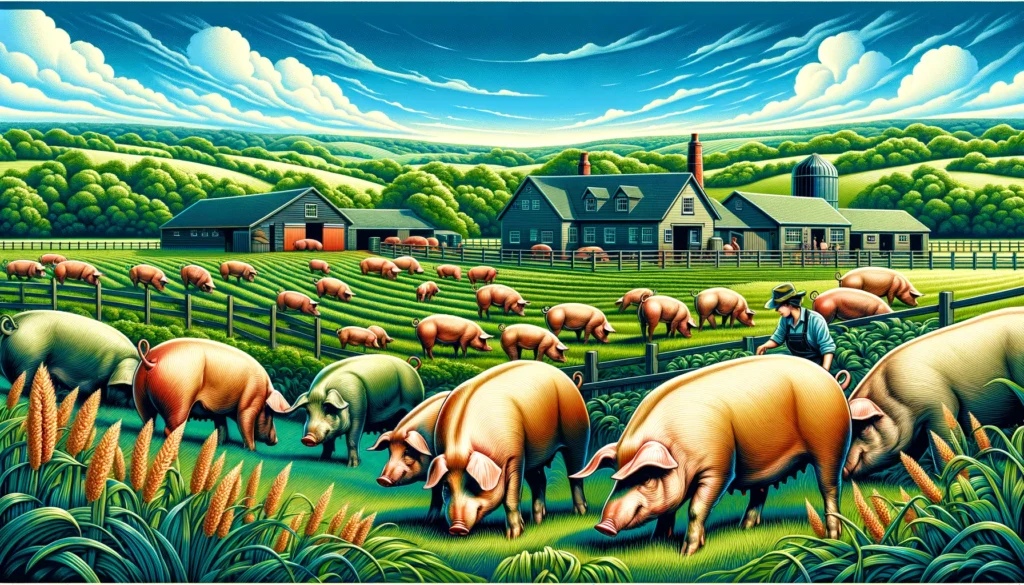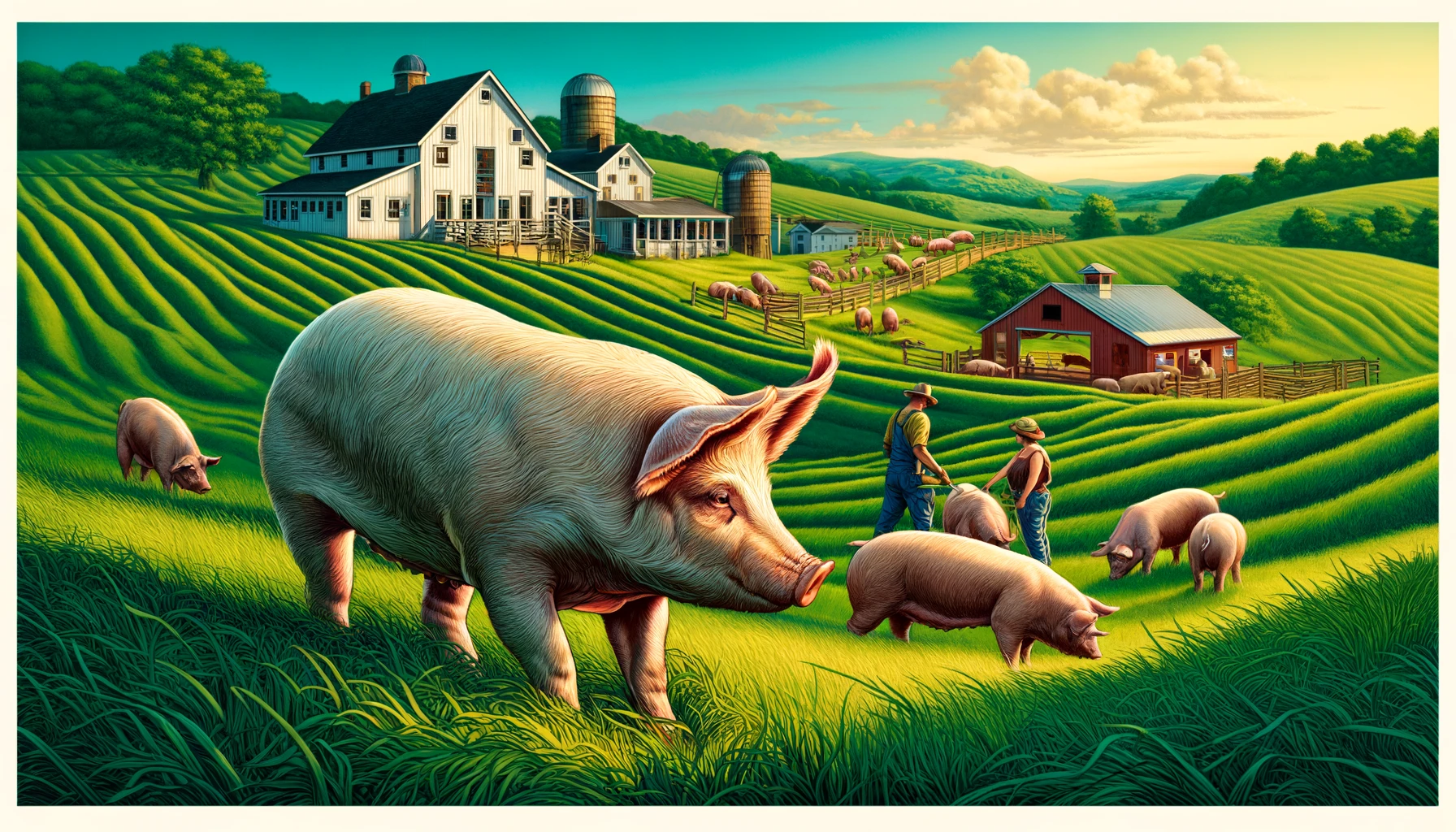Farming Landrace Hogs: A Comprehensive Guide
Farming Landrace Hogs
Landrace hogs are a popular breed in the agricultural community, known for their excellent reproductive capabilities, adaptability, and high-quality meat. These pigs, originally from Denmark, have been selectively bred to excel in various farming environments, making them an ideal choice for both small-scale and commercial pig farming operations.
In this comprehensive guide, we will explore the history, characteristics, and benefits of farming Landrace hogs, as well as provide practical advice on how to raise and manage these animals effectively. We will also discuss breeding techniques, nutrition, housing, health care, and marketing strategies to help farmers optimize their Landrace hog operations.
History and Characteristics of Landrace Hogs
Origin and Development
Landrace hogs originated in Denmark in the late 19th and early 20th centuries. Danish farmers began selectively breeding local pigs with imported Large White hogs from England to improve the quality and productivity of their herds. The result was the creation of the Danish Landrace, a breed that quickly gained popularity for its exceptional reproductive performance and high-quality meat.
Over the years, Landrace hogs have been further refined through selective breeding programs in various countries, including the United States, Canada, and several European nations. Today, Landrace hogs are recognized for their uniform appearance, strong maternal instincts, and adaptability to different farming systems.
Physical Characteristics
Landrace hogs are medium to large-sized pigs with a distinctive long, white body and drooping ears. Their physical characteristics include:
- Body Length: Landrace hogs have a long, deep body, which contributes to their excellent meat production capabilities.
- Color: They are predominantly white, with occasional dark spots or freckles on their skin.
- Ears: Their ears are large and drooping, which helps protect their eyes from dirt and debris.
- Legs: Landrace hogs have strong, well-developed legs that support their large frame and allow them to move comfortably in various environments.
Temperament and Behavior
Landrace hogs are known for their calm and docile temperament, making them easy to handle and manage. Their strong maternal instincts also make them excellent mothers, capable of raising large litters of piglets with minimal intervention from farmers.
Benefits of Farming Landrace Hogs
High Reproductive Performance
One of the primary advantages of farming Landrace hogs is their exceptional reproductive performance. Landrace sows are known for their high fertility rates, large litter sizes, and excellent mothering abilities. This translates to a higher number of piglets per breeding cycle, which can significantly increase the profitability of a pig farming operation.
Quality Meat Production
Landrace hogs are highly regarded for their high-quality meat, which is lean, tender, and flavorful. Their long body and well-developed muscle structure contribute to a higher yield of prime cuts, making them a preferred choice for both fresh pork and processed products. The consistent quality of Landrace pork also makes it easier for farmers to market their products to consumers and meat processors.
Adaptability and Hardiness
Landrace hogs are adaptable to a wide range of farming systems, from traditional pasture-based setups to modern confinement operations. They are hardy animals that can thrive in various environmental conditions, provided they receive proper care and management. This adaptability makes Landrace hogs a versatile choice for farmers looking to diversify their livestock operations.
Efficient Growth and Feed Conversion
Landrace hogs are efficient converters of feed into muscle, which means they can achieve optimal growth rates with a balanced diet. This efficiency reduces feed costs and improves the overall profitability of pig farming. Additionally, their well-developed digestive systems allow them to utilize a variety of feed sources, including grains, forage, and agricultural by-products.
Getting Started with Landrace Hog Farming
Selecting Breeding Stock
Choosing the right breeding stock is crucial for the success of a Landrace hog farming operation. When selecting breeding animals, consider the following factors:
- Genetics: Look for animals with a proven pedigree and strong genetic traits, such as high fertility, good mothering abilities, and excellent meat quality.
- Health: Ensure that the animals are healthy and free from any genetic defects or diseases.
- Conformation: Select hogs with a uniform appearance, strong legs, and a well-developed body structure.
Housing and Facilities
Proper housing and facilities are essential for the health and well-being of Landrace hogs. Consider the following guidelines when setting up your pig farming operation:
- Space Requirements: Provide adequate space for each pig to move comfortably. As a general rule, allow at least 8-10 square feet per adult pig in indoor facilities.
- Ventilation: Ensure proper ventilation to maintain good air quality and prevent respiratory issues. Use fans, vents, and windows to promote air circulation.
- Bedding: Provide clean, dry bedding, such as straw or wood shavings, to keep the pigs comfortable and reduce the risk of disease.
- Fencing: Use sturdy fencing to contain the pigs and protect them from predators. Electric fencing can be an effective option for outdoor setups.
- Shelter: Provide adequate shelter to protect the pigs from extreme weather conditions, such as heat, cold, and rain.
Nutrition and Feeding
Proper nutrition is crucial for the growth and productivity of Landrace hogs. Develop a balanced feeding program that meets the nutritional needs of different stages of growth:
- Starter Feed: Provide a high-quality starter feed for piglets, which should contain around 20-22% protein to support rapid growth and development.
- Grower Feed: Transition to a grower feed with 16-18% protein as the pigs mature. This feed should also include essential vitamins and minerals to support overall health.
- Finisher Feed: Use a finisher feed with 14-16% protein for market-ready pigs. This feed should promote muscle development and ensure high meat quality.
- Supplementation: Consider adding supplements, such as vitamins, minerals, and probiotics, to the pigs’ diet to enhance their health and productivity.
Health Care and Disease Management
Maintaining the health of Landrace hogs is critical for the success of a pig farming operation. Implement a comprehensive health care program that includes:
- Vaccinations: Administer routine vaccinations to protect the pigs from common diseases, such as swine flu, porcine parvovirus, and E. coli.
- Parasite Control: Implement a parasite control program to prevent infestations of internal and external parasites, such as worms, lice, and mites.
- Biosecurity: Practice good biosecurity measures to prevent the introduction and spread of diseases. This includes controlling access to the farm, disinfecting equipment, and isolating new or sick animals.
- Veterinary Care: Establish a relationship with a local veterinarian who specializes in swine health. Regular check-ups and prompt treatment of any health issues are essential for maintaining a healthy herd.
Breeding and Reproduction
Effective breeding management is key to maximizing the reproductive potential of Landrace hogs. Follow these guidelines for successful breeding and reproduction:
- Breeding Age: Gilts (young female pigs) can be bred at around 8-9 months of age, while boars (male pigs) can start breeding at 7-8 months.
- Estrus Detection: Monitor sows for signs of estrus (heat), which include restlessness, swollen vulva, and standing still when pressure is applied to the back.
- Mating: Natural mating or artificial insemination (AI) can be used for breeding. AI allows for better genetic selection and reduces the risk of disease transmission.
- Gestation: The gestation period for pigs is approximately 114 days (3 months, 3 weeks, and 3 days). Provide proper nutrition and care to pregnant sows to ensure healthy litters.
- Farrowing: Prepare a clean and comfortable farrowing area for the sow to give birth. Monitor the farrowing process and provide assistance if needed.
- Weaning: Piglets are typically weaned at 3-4 weeks of age. Gradually transition them to solid feed and provide a clean and warm environment to reduce stress.
Marketing and Selling Landrace Hogs
Developing a marketing strategy is essential for selling Landrace hogs and their products. Consider the following tips to maximize your sales:
- Market Research: Conduct market research to identify potential buyers and understand their preferences. This can help you tailor your products and marketing efforts to meet their needs.
- Branding: Develop a strong brand identity that highlights the quality and benefits of your Landrace hogs. Use logos, labels, and packaging to create a professional and appealing image.
- Direct Sales: Consider selling your products directly to consumers through farmers’ markets, online platforms, or farm stores. This allows you to capture a larger share of the market and build relationships with your customers.
- Wholesale: Partner with local meat processors, restaurants, and grocery stores to sell your products in bulk. This can provide a steady and reliable source of income.
- Value-Added Products: Explore opportunities to create value-added products, such as sausages, bacon, and smoked meats. These products can command higher prices and attract a wider range of customers.
Case Study: Successful Landrace Hog Farm
To illustrate the principles and practices discussed in this guide, let’s look at a case study of a successful Landrace hog farm.
Farm Background
Green Valley Farms is a family-owned pig farm located in the Midwest. The farm started with a small herd of Landrace hogs and has since grown into a thriving operation with over 200 breeding sows and a state-of-the-art processing facility.
Key Practices
Green Valley Farms attributes its success to the following key practices:
- Selective Breeding: The farm focuses on selective breeding to improve the genetic traits of their Landrace hogs. They use artificial insemination and track the performance of each animal to ensure continuous improvement.
- Nutrition Management: The farm develops customized feeding programs for each stage of growth, using high-quality feed and supplements. They also grow their own grain to reduce feed costs and ensure quality control.
- Health Care: Green Valley Farms implements a comprehensive health care program, including routine vaccinations, parasite control, and biosecurity measures. They work closely with a swine veterinarian to monitor and address any health issues.
- Sustainable Practices: The farm practices sustainable farming techniques, such as rotational grazing, manure management, and water conservation. These practices help reduce their environmental impact and improve the health and productivity of their hogs.
- Marketing and Sales: Green Valley Farms has developed a strong brand identity and markets their products through direct sales and wholesale channels. They also offer value-added products, such as bacon and sausages, which have become popular with local consumers.
Results
Green Valley Farms has achieved significant success with their Landrace hog farming operation. They have increased their herd size, improved the quality of their products, and built a loyal customer base. Their focus on sustainability and animal welfare has also earned them recognition and support from the local community.
Conclusion
Farming Landrace hogs can be a rewarding and profitable venture for farmers who are willing to invest in proper management and care. With their exceptional reproductive performance, high-quality meat, and adaptability, Landrace hogs offer numerous benefits for both small-scale and commercial pig farming operations.
By following the guidelines and best practices outlined in this guide, farmers can successfully raise and manage Landrace hogs, optimize their production, and maximize their profitability. Whether you are just starting out or looking to improve your existing pig farming operation, the insights and strategies provided in this comprehensive guide will help you achieve your goals and succeed in the competitive world of pig farming.

